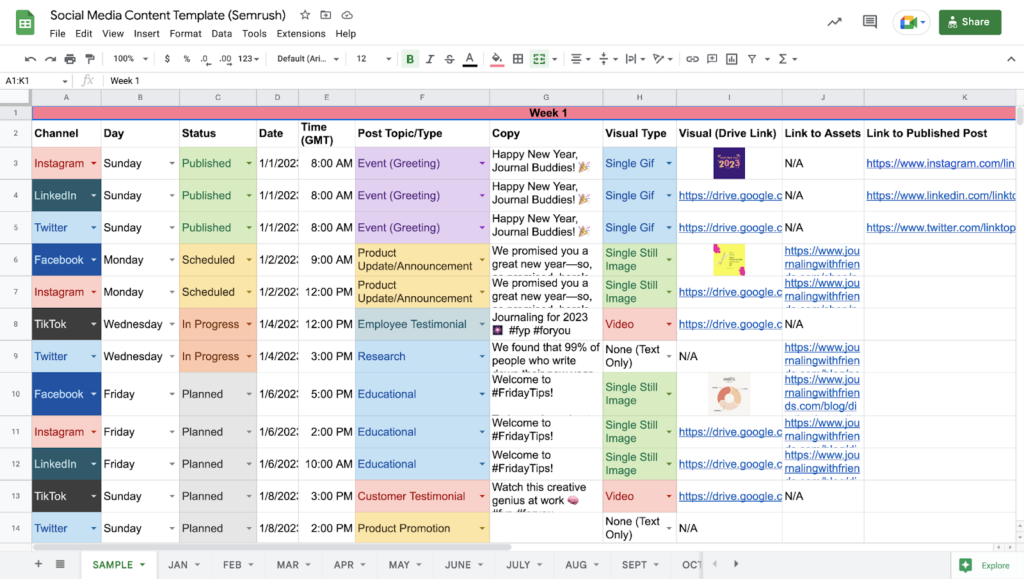In today’s fast-paced digital landscape, creating and managing a content calendar is no longer optional; it’s an absolute necessity. A content calendar is a visual workflow that outlines what content will be published, when, and where. It serves as the blueprint of your digital marketing strategy, providing a bird’s-eye view of your efforts and allowing you to plan for the future.
This guide will navigate you through the creation of a robust content calendar, ensuring your digital marketing campaigns stay organized, focused, and effective.
The Value of a Content Calendar
A well-maintained content calendar fuels organization’s digital marketing and ensures consistency in your marketing efforts. By having a clear view of what’s being published and when, you reduce last-minute scrambles and rushed content. It aids in maintaining a steady stream of quality content, vital for audience engagement and SEO. Additionally, a content calendar facilitates better team collaboration and helps track what works and what doesn’t. This way, your strategy grows not just from foresight, but also hindsight—leading to more effective marketing.
Understanding Your Audience and Goals
The first step in building a content calendar is understanding your audience and goals. Identifying who your audience is, their needs, preferences, and behavior online forms the backbone of your content strategy. Simultaneously, clear, measurable goals guide your content creation.
Whether it’s to increase website traffic, improve SEO rankings, or boost social media engagement, your goals should be SMART (Specific, Measurable, Achievable, Relevant, and Time-bound). Pairing an in-depth audience understanding with clear objectives provides a strong foundation for your content calendar.
Choosing the Right Platforms
Your choice of platforms is dictated by your audience and goals.
If your audience frequents Facebook and your goal is to build community, that’s your platform. If it’s professionals you’re after with thought leadership content, LinkedIn is a better bet. Blogs are great for detailed, SEO-friendly content, while newsletters can nurture your existing subscribers. Diversify your presence but prioritize platforms based on your target audience’s behavior and your marketing objectives. Remember, each platform may demand unique content types and post frequencies.
Content Ideation
Once you understand your audience, goals, and platforms, it’s time to brainstorm content. Think about topics your audience cares about and how these align with your brand. Diversify content types—blogs, videos, infographics, podcasts—to keep your audience engaged. Tools like Google Trends, BuzzSumo, or even your competitors’ content can offer inspiration. Also, consider seasonal events, industry updates, or user-generated content. Remember to keep a balance between promotional and value-adding content.
All ideas should ultimately support your goals and resonate with your audience. Consider utilizing content pillars to help keep things organized and inline with your goals.
Creating a Content Schedule
The key to a content schedule is regularity and timeliness. Analyze when your audience is most active and pair it with the platform’s best practices. For instance, B2B content performs well on weekdays, while B2C content might get more engagement over the weekend.
Remember, different platforms may demand different posting frequencies. Tools like Hootsuite and Buffer provide insights into optimal post times. Also, plan for flexibility. While scheduling is important, being responsive to current events or trending topics can show your brand is reactive and relevant.
Tools for Creating a Content Calendar
There’s a wealth of tools to assist in content calendar creation and management. Google Sheets is a free, collaborative option, but dedicated platforms like CoSchedule or Trello offer more advanced features like automated posting, integrated analytics, and easy rescheduling.
Explore your options and choose one that fits your needs and budget. Remember, the tool is supposed to aid your process, not complicate it.
Updating and Evaluating Your Content Calendar
No content calendar should be set in stone. It should be reviewed and updated regularly to accommodate changes in strategy or audience behavior. Monitor your content’s performance and analyze what works and what doesn’t. Use metrics like engagement, reach, and conversions to evaluate your success. Adjust your calendar and content strategy based on these insights. A content calendar is not a “create and forget” tool, but a dynamic, evolving framework that grows with your digital marketing efforts.
Creating a content calendar is a key step in executing a successful digital marketing strategy. By aiding organization, ensuring consistent quality content, and allowing for analytical insights, a content calendar can significantly improve your marketing efficiency. It’s time to move away from ad-hoc content creation and start planning with purpose. So, grab your audience insights, set your goals, pick your tools, and start crafting your content calendar today. Your digital marketing efforts will thank you for it.







